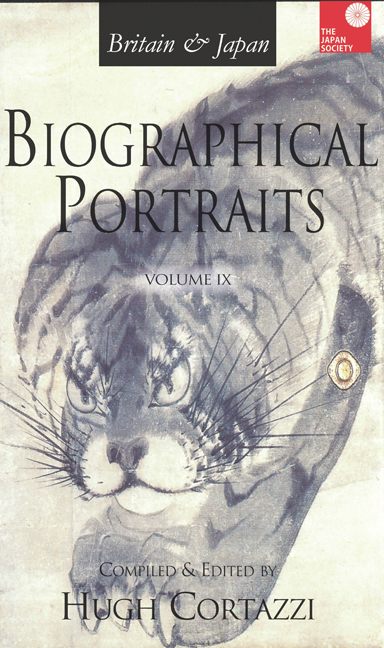Book contents
- Frontmatter
- Contents
- Introduction
- List of Contributors
- Index of Biographical Portraits in Japan Society Volumes
- PART I JAPAN IN BRITAIN: THINGS JAPANESE
- PART II BRITAIN IN JAPAN: TRADE
- BRITISH ACTIVITIES
- MISSIONARIES
- MUSIC, DRAMA AND FILM
- EPISODE
- PAINTERS
- JOURNALISTS
- JAPANESE WOMEN PIONEERS
- PART III SCHOLARS AND WRITERS: JAPANESE
- BRITISH
- PART IV POLITICIANS AND OFFICIALS: JAPANESE
- BRITISH OFFICERS
- BRITISH JUDGES AND A DIPLOMAT
- BRITISH POLITICAL FIGURES
- Index
2 - Haiku in the British Isles: A Tale of Acceptance and Non-acceptance
Published online by Cambridge University Press: 30 April 2022
- Frontmatter
- Contents
- Introduction
- List of Contributors
- Index of Biographical Portraits in Japan Society Volumes
- PART I JAPAN IN BRITAIN: THINGS JAPANESE
- PART II BRITAIN IN JAPAN: TRADE
- BRITISH ACTIVITIES
- MISSIONARIES
- MUSIC, DRAMA AND FILM
- EPISODE
- PAINTERS
- JOURNALISTS
- JAPANESE WOMEN PIONEERS
- PART III SCHOLARS AND WRITERS: JAPANESE
- BRITISH
- PART IV POLITICIANS AND OFFICIALS: JAPANESE
- BRITISH OFFICERS
- BRITISH JUDGES AND A DIPLOMAT
- BRITISH POLITICAL FIGURES
- Index
Summary
FIRST ENCOUNTERS WITH THE FORM
LAFCADIO HEARN (1850–1904, native of the British Isles who took Japanese citizenship) and Basil Hall Chamberlain (1850–1935, English Japanese scholar), both writing around the turn of the twentieth century, are thought to be the first to introduce readers in the British Isles to the Japanese haiku. Both employed the older term hokku, rather than ‘haiku’; not a mistake, as the Japanese reformist Masaoki Shiki had only recently preferred the use of ‘haiku’. But they did miss a mark by describing the hokku as ‘the Japanese epigram’.
Hearn offers ‘a small selection of hokku ’ in his Kwaidan - Stories and Studies of Strange Things (1904); and it is very much as ‘strange things’ he presents these minimalist poems to us. He could use them, he thought, to illustrate ‘Japanese interest in the aesthetic side of the subject’ of butterflies. He has no real belief that the hokku might ever catch on as a form practised by Western poets:
The taste for Japanese poetry of the epigrammatic sort is a taste that must be slowly acquired; and it is only by degrees, after patient study, that the possibilities of such composition can be fairly estimated. Hasty criticism has declared that to put forward any serious claim on behalf of seventeen syllables ‘would be absurd’.
A hundred years later, James Fenton, Professor of Poetry at Oxford, writing in An Introduction to English Poetry, was still finding the idea of assimilation absurd:
The most familiar form of syllabic verse is the haiku, borrowed from the Japanese, in which the poem adds up to seventeen syllables divided into three lines of five, seven and five syllables respectively. To me this seems like an oriental tradition which, however enthusiastically adopted (particularly in schools, I find), is unlikely to have an equivalent effect in the West. A bit like the tea ceremony.
This essay will seek to convince the reader that Fenton's opinion is far from the truth.
Lafcadio Hearn's versions take the form of a single sentence of prose, not formally presented as a monostich.
- Type
- Chapter
- Information
- Britain & Japan Biographical Portraits Vol IX , pp. 15 - 27Publisher: Amsterdam University PressPrint publication year: 2015



